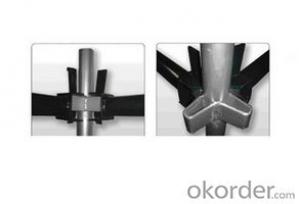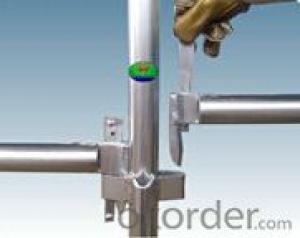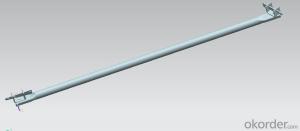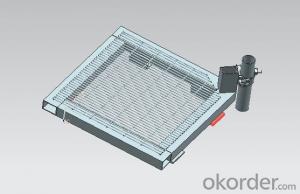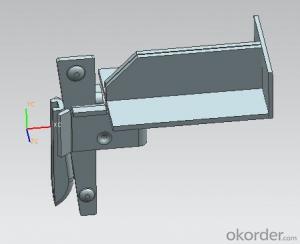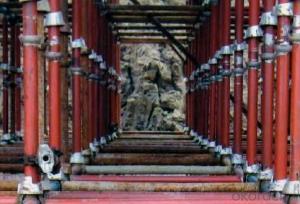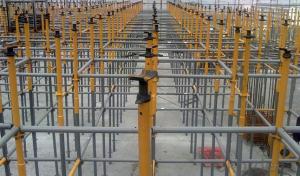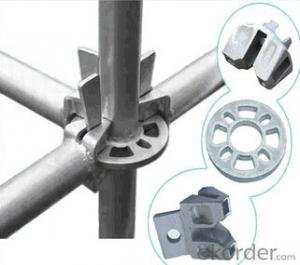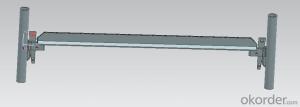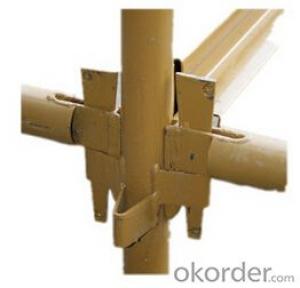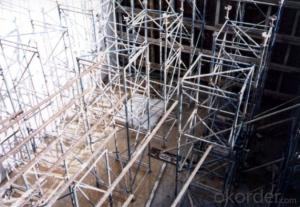S-Stage (Quick Stage) Systems, Standards
- Loading Port:
- Tianjin
- Payment Terms:
- TT OR LC
- Min Order Qty:
- 10000 PCS
- Supply Capability:
- 10000 PCS/month
OKorder Service Pledge
OKorder Financial Service
You Might Also Like
Quick Details
| Place of Origin: | Maharashtra India | Brand Name: | UE | Model Number: | 04-01 |
| As per the clients requirements: | Exporting Products |
Specifications
Made from 48.3OD x 4mm thick Steel Tubes with housings at four directions at right angles. Standards have spigot welded to them.
S-STAGE (QUICK STAGE) SYSTEM
Consist of Standards with wedge housing welded to them at 500mm centers in four directions at right angles. Ledgers and Transoms with banana end brackets connect to the verticals with positive locking wedges fit in the wedge housings of standards. The Diagonals have a swiveling bracket with positive wedge locking to the standards. Standards are erected on adjustable Base Jack to cope with variation in Ground level.
Made from 48.3 OD x 4 mm thick Steel Tubes with housings at four directions at right angles. Standards have spigot welded to them to connect one above the other. Standard sizes are 9ft.9in, 6ft. 6in & 3ft3in.
Conforms to BS Standards.
Dip painted to give protection inside the tubes
The elements constituting the system:
§ Vertical element
§ Horizontal element
§ Lower universal jack and jack nut
§ Upper universal jack and jack nut
§ Connection tool for vertical elements
§ Beam supporting element
§ Console
§ Base jack
- Q: It involves construction, just don't know what it is exactly? Thanks!
- elevated horizontal planks upon which workers stand to perform repair, installation, or similar.
- Q: Where can I find safety standards for Scaffolding?
- ANSI A10.8-2001 Safety Requirements for Scaffolding Scope: Establishes safety requirements for the construction, operation, maintenance, and use of scaffolds used in the construc- tion, demolition and maintenance of build- ings and structures.
- Q: Why is there scaffolding on this building if it is under going demolition ?
- Probably it is being disassembled, not demolished. This saves the parts like glass, metal for salvage.
- Q: About 5 days ago I got a scaffolding piercing done in my left ear, today I found a small bump behind the ear and I was wondering if I should get it checked out or if it's normal.The bump is directly behind my ear but on my head, and it's hard and feels kind of bone-like. It's not huge but not tiny, about the size of a marble. Also it doesn't hurt at all, I didn't even notice it was there until I felt behind my ear. I'm pretty sure it wasn't there yesterday so it must have only popped up today.Thanks. (:
- it will be a harmless lymph node that has enlarged because of the piercing
- Q: A. from peersB. nonverbalC. done in informal settingsD base on the level of the learner's needs
- Hi, Mary, How about doing a quick online search for scaffolding teaching? You'll find over a million pages that discuss the topic -- many from top education schools. You'll get an answer lots faster than you will here!
- Q: Should the WWE hire New Jack & have him work a program with Cena, culminating in a scaffold match?
- New Jack should be hired to go up against a monster truck see can he throw it before it runs him over..that bum shouldnt even be mentioned as a wrestler.
- Q: I need to reach my very high ceiling. Where can I rent scaffolding?
- why don't you google scaffold rental in your area...
- Q: In The Scarlet Letter
- Your question is not a special ed question. Your question belongs in homework help.
- Q: If a medical student begins working in an internship program, and is gradually assigned to treat patients under the close supervision and guidance of an experienced doctor, how would instructional scaffolding be represented in this scenario? I'm having trouble understanding this concept for my education psych class!Thanks in advance for the help!! :)
- Scaffolding supports construction workers so that they don't fall off the roof beams, for example. Scaffolding in education means giving students support- not leaving them hanging off a ledge. You don't want a med student to go from reading about diseases in a textbook to treating patients on his/her own. There has to be a transition. The student reads the files, examines the patients, talks to the patient, and then makes a diagnosis and prescribes a treatment. The scaffolding is having an experienced doctor there to say the student make the right decision, or to point out where the student went wrong- before the patient gets the wrong treatment or medicine.
- Q: What ever happened to scaffold matches?
- WTF is a scaffold match
Send your message to us
S-Stage (Quick Stage) Systems, Standards
- Loading Port:
- Tianjin
- Payment Terms:
- TT OR LC
- Min Order Qty:
- 10000 PCS
- Supply Capability:
- 10000 PCS/month
OKorder Service Pledge
OKorder Financial Service
Similar products
Hot products
Hot Searches
Related keywords
